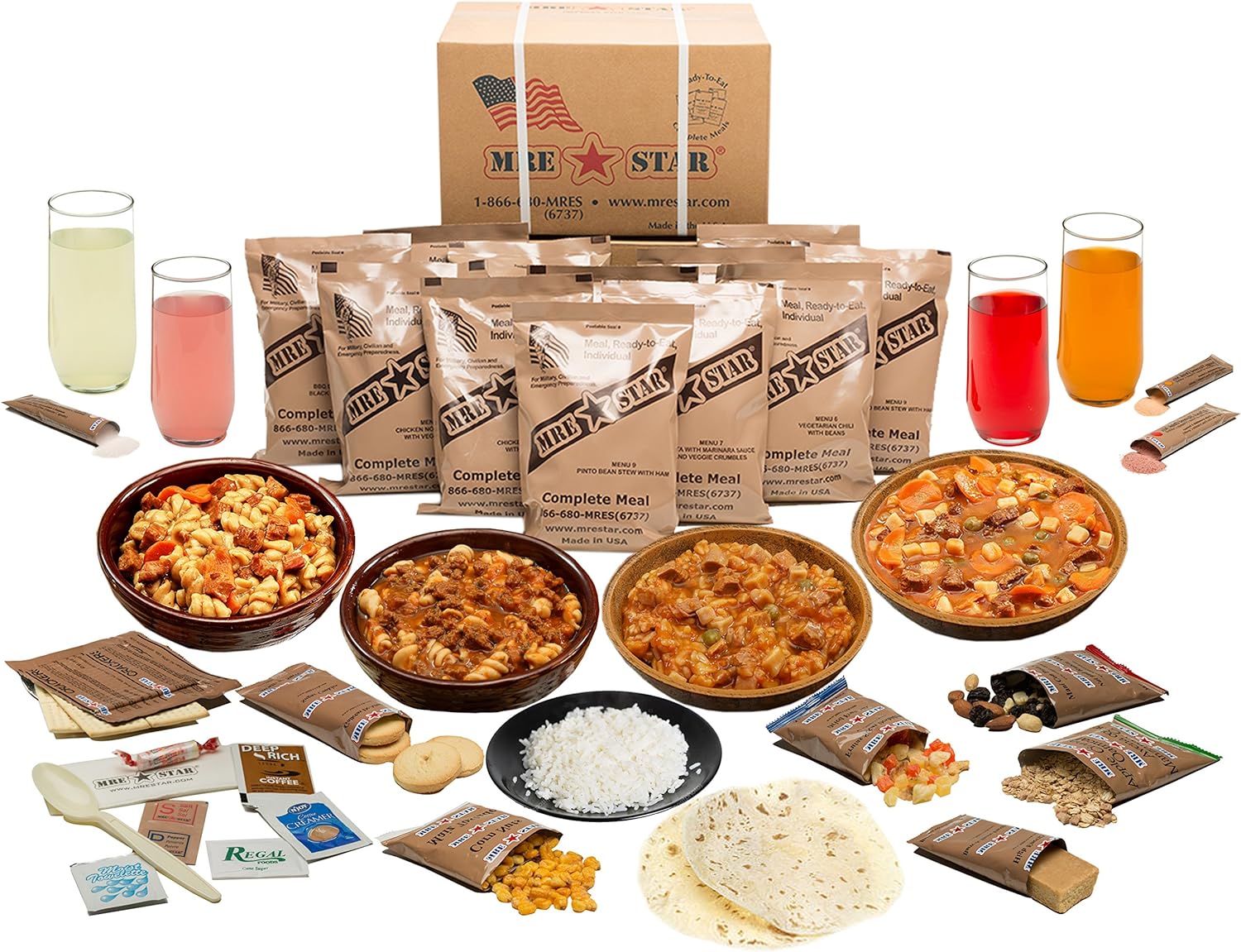If you consider it, the entire population of California is still determining where their next meal will come from. This uncertainty is a fact of life for 38.3 million Americans, or just under California's population of 39.5 million.
Although the effects of poverty are numerous and diverse, many of them, like homelessness, a lack of access to healthcare, and poor salaries, are regularly discussed in public.
However, a number go largely unnoticed. Among these is a problem with food insecurity alone.
Food insecurity is one of the most significant nutrition-related public health challenges in the U.S. because of its prevalence and several documented negative health effects.
What is food insecurity?
According to the USDA, food security "means everyone having access to enough food at all times for a healthy life."
However, a food insecurity problem affects over 10% of Americans. 11.7 million of these 38.3 million people are children, which is higher than the whole population of New York City.
Such statistics about food programs also raise challenging concerns, such as why and who these families and individuals struggle with food insecurity.
What effects do so many people going hungry have on our society? Finally, what can we do to resolve this serious problem? In this post, we will learn about food insecurity and several solutions.
Therefore, whenever a person or family does not have access to adequate food, it is considered to be experiencing food insecurity.

Different families and individuals deal with and experience food insecurity. To clarify these varying experiences of food insecurity, the USDA provides four main ranges of both food security and food insecurity:
Food Security:
-
High Food Security: According to the USDA, high food security refers to people or families that do not report problems accessing food or experiencing any restrictions. These families are not particularly concerned about eating.
-
Marginal Food Security: According to the USDA, households with marginal food security occasionally worry about running out of food, but they don't make any noticeable dietary or consumption modifications.
Food Insecurity:
-
Low food security: Although they may not necessarily eat less food overall, households or individuals with low food security report eating food of inferior quality, less variety, and generally having a less adequate diet.
-
Very Low Food Security: Families with very low levels of food security report that their dietary habits and intake have been altered in some way. These individuals and families could skip meals to spread their food out over more time.
Food insecurity is when an individual or group doesn't have adequate access to or money to buy nutritious food. Although hunger may be a symptom of food insecurity, hunger is not the same as food insecurity.
Who is Food Insecure?
We've already mentioned how food insecurity most significantly impacts children, with all of the hungry children in America filling a city the size of New York. But which communities in rural areas are the hardest hit by food insecurity?
The answer, however, is a challenge.
Food insecurity affects more than one in ten Americans and can be discovered in each community. However, some communities experience greater impacts than others.
People who are more likely to experience food insecurity include:
-
The risk of food insecurity is more than twice as common among non-Hispanic Black and Hispanic households than in non-Hispanic White households.
-
Households with lower incomes (those under 185% of the poverty line) compared to families with higher incomes.
-
Families with kids, especially those under 5, compared to families without kids.
-
Families with only one adult as the head, especially single women-headed households.
Recent statistics show 38.3 million Americans, from which 11.7 million were children, facing food insecurity. This problem goes beyond bare figures as it represents many people with unhealthy diet preferences who outweigh the population of cities like New York.
To better understand the scale and impact of food insecurity, the following table summarizes key statistics sourced from the United States Department of Agriculture (USDA):
Statistic |
Figure |
|---|---|
|
Total People Affected |
38.3 million |
|
Children Affected |
11.7 million |
|
Percentage of U.S. Population |
Over 10% |
These figures imply that not only must the main causes of food insecurity in society be sought, but the impact of the issue on society must be understood, and appropriate measures should be taken to tackle it.
When discussing food insecurity, holistic solutions must be considered to ensure the full provision of nutritious and sufficient food for all the nation's citizens.
What is the main cause of food insecurity?
In the U.S., food insecurity is no longer connected to the poverty line but instead a much more complex combination of historical, economic, and social factors.
Namely, various factors have caused this to become a concern for the state. Nevertheless, poverty is the critical factor contributing most to the problem of deficient food supply and quality.
The Role of Food Deserts
One of the main food insecurity issues is the existence of food deserts that show the crucial background of city planning, economic disparity, and healthy food access.
"Food desert" is where it is difficult to find affordable, healthy food, sometimes located farther than a mile in a city and 10 miles from rural settings.
-
Urban vs. Rural: Food deserts are addressed differently in urbanized and rural settings. Cities deprived of community grocery stores force residents to travel longer distances and search for healthy food, while in rural areas, the demand for food retailers remains nonexistent.
-
Transportation and Accessibility: People who own a car or use fixed-scheduled public transport might be fortunate, but others who can not find a vehicle or proper public transport live in a food desert that does not help them buy affordable food, leading to food insecurity.
-
Socioeconomic Factors: Food deserts are often geographically associated with areas of high poverty and limited economic development, where residents find that not only is access to food stores limited, but even when they can purchase food, healthy food options can be financially beyond their pocket.
-
Health Implications: Residents of a food desert county may rely on traveling to far-off 24-hour convenience stores or fast food chains, which can lead to poor eating habits, obesity, and related diseases such as diabetes and heart disease.
-
Community and Policy Responses: Building community gardens, introducing mobile markets, and incentivizing supermarkets to open in underserved areas are all workable ways to address the challenges of food deserts. Policy initiatives are supposed to ensure food access and build supportive communities.
Recognizing the nature of food deserts involves acknowledging them as the problem of short physical distance from grocery stores and a complex issue spread over poverty, lack of infrastructure, and other social disparities.
Addressing food deserts is one way to combat food insecurity. Other approaches include improving physical access and providing more affordable and nutritious food.
Another approach is to address the low-income social issues resulting from these disparities.
Poverty: The Primary Cause of Food Insecurity
Poverty is the main driver behind food insecurity. Limited financial resources restrict households' ability to purchase adequate and healthy food.
- USDA Findings: According to a 2014 USDA report, geographic access to food stores does not directly correlate with food insecurity levels. The real issue lies in the affordability of food for low-income families.
- Income and Food Spending: Many low-income households allocate over 25% of their income to food, compared to middle- and high-income families, who spend a larger amount but a smaller percentage of their income. Low wages and historical discrimination exacerbate this disparity.
In summary, while geographical access and urban development issues like food deserts contribute to food insecurity in the United States, poverty is the root cause.
Addressing this challenge requires focusing on economic policies and support systems, ensuring everyone can access nutritious food.
What is the effect of food insecurity?

Food insecurity is a factor greatly influencing families' budget planning.
Households who are food insecure and spend more than 27% of their income on food items have difficulty paying for necessities such as housing, utilities, healthcare, and nutrition.
People often face this conflict, and the trade-offs seem impossible. They usually have to choose between sleeping on their roofs, eating healthy food, or receiving prescribed medical treatment.
Health Effects of Food Insecurity
- Chronic Illnesses: Adults with poor food security may have increased odds of chronic issues like diabetes, obesity, and depression. Being deprived of quality diets impairs the health status of such individuals and, therefore, the proportion of people with diet-related health problems shows the clear link between food security problems and poor health consequences.
Duration and Variability of Food Insecurity
- Temporary vs. Long-term: Food insecurity can be a temporary challenge during financial setbacks, such as a family member losing a job, or a persistent issue for individuals unable to work due to disability. The duration and variability of food insecurity significantly affect the severity of its impact on families and individuals.
Impacts on Physical Health and Academic Performance of Children
- Developmental Risks: It is highly detrimental for children to suffer from food deprivation for a long time. It can slow down children’s development, and the effects can follow these children into adulthood.
- Academic Challenges: Malnutrition can adversely affect the overall health of the learners, hence noting more school days. This makes the recovery challenging. Difficulty paying attention in class and memorizing the material may lead to lower academic achievement and a less enjoyable learning process.
Food insecurity has various dimensions, encompassing nutrition expenditure, chronic health, and academic performance.
It brings up terrible dilemmas between basic needs, enhances the chance of chronic diseases, and undermines children's development and education.
Confronting the issue of food insecurity involves a range of solutions, uncovering its immediate effects and long-term implications. The main purpose is to ensure everybody has regular access to enough nourishing food.
Solutions to Ending Food Insecurity
A comprehensive approach that addresses the root problems and offers long-lasting solutions will solve food insecurity.
Improving federal food programs will reduce the resources communities need to combat food poverty and reduce waste. Ensuring enough nutritious meals for children in schools is vital.
Through these programs, many families will receive support that will yield good health, increased well-being, and better long-term economic viability.
Enhancing SNAP Benefits
-
Update the Thrifty Food Plan: Revise the principle of eligibility for nutritional support to reflect the current food prices and dietary standards expected from the citizens of the United States. This should be a prerequisite for a healthy future of this nation’s citizenry.
-
Adjust Benefits by Geographic Cost of Living: Consider the price differences between regions during the SNAP program, especially where accommodation is expensive and it is challenging to survive with minimal food funds allocated.
-
Consider Time Constraints for Meal Preparation: Acknowledge that low-wage workers have limited time to prepare nutritious meals. Provide manageable SNAP benefits for quick and healthy meal options as a solution.
Reducing Food Waste
-
Implement Uniform Labeling Standards: Ensure consistency of food labels to eliminate the difficulties of similarity of best-by, use-by, and sell-by dates and, hence, avoid rubbish food choices.
-
Encourage Food Donations: Pass a law incentivizing retailers to participate in food donation programs. This will alleviate community hunger and protect them against any legal action they may face.
-
Public Awareness Campaigns: Enlighten them through their knowledge of food preservation and food waste to avoid going to waste to feed the needy.
Offering Free School Lunches
- Universal Free School Meals: Make lunch an obligation for all students and ensure their food is nutritious. This would provide an equitable way to enrich all lives. Lunch is central to education and health.
Benefits Include:
- This goal will lead to less discrimination and more active involvement in community meal programs.
- Improved meal quality and supply of fresh plant-based edibles.
- The chance of high performance among poor students will significantly increase due to high attendance.
Overcoming food insecurity requires a broader approach, which includes immediate solutions and long-term perspectives.
Revising federal nutrition programs such as SNAP, implementing ways to reduce food waste, and offering universal free school lunches can achieve great results in the fight against hunger and in ensuring the health and success of young generations.
These solutions help treat the effects of food insecurity and get to their roots, and they are the first step to a better and more just society.
Community
Food insecurity impacts every neighborhood, state, and region, and it is more widespread in certain regions than others.
An excellent method to alter things for the better in your community is to aid in reducing food insecurity. Whatever your comfort level, there are a few easy ways to get involved and have an influence.
Volunteer:
Volunteering with food banks, cooperatives, and mutual aid networks is a fantastic way to combat food insecurity and build ties within your community. Everyone benefits from volunteering: it allows you to meet new people, establish relationships, learn new skills, and enjoy yourself (truly!).
Contact Your Representatives:
You need the power to bring about systemic change. Your local and national elected officials work for you and your neighborhood. Contact them using your voice to express your worries about hunger and food insecurity. Here, you can locate the local representative you need.
Donate:
Many groups working to end hunger and combat food insecurity are always grateful for donations. Your contributions to food banks, whether cash or food items, may significantly aid those in need.
Act Now to Combat Food Insecurity
Although the United States is frequently cited as having the planet's most plentiful land, millions of children, who make up more than a tenth of our population, face food insecurity even though we produce more than we can consume.
While various elements contribute to food insecurity, poverty is the most blatant and responsible.
Given that we now waste away more than 30% of the food we produce, the aid and assistance we give to our less fortunate brothers and sisters is insufficient, and we are financially able to do much more.
Although addressing food insecurity is extremely difficult, it is possible. Systemic and community change are also possible; they are frequently the same.






















































